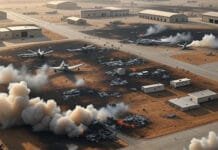The crisis in Syria has taken a dramatic turn, with significant developments reshaping the region’s political and military landscape. The fall of Bashar al-Assad’s regime marks a critical moment in Syria’s tumultuous history. From his exile in Russia to the intensified US military actions against ISIS, these unfolding events are pivotal. Here’s a comprehensive overview of the situation in Syria.
Assad Flees Syria: A Nation in Turmoil
The fall of President Bashar al-Assad’s regime has ushered in a new chapter in Syria’s history. Reports confirm that Assad and his family have fled to Moscow, where they have been granted political asylum by Russian President Vladimir Putin. The announcement by the Syrian military marked the end of over five decades of Assad family rule.
Capital Falls to Rebel Forces
Rebel forces have gained control of Damascus, the capital of Syria, after days of intense fighting. Rebel commander Abu Mohammad al-Golani addressed a massive gathering, declaring the victory as a historic moment for the region. Celebrations erupted as fighters claimed the city, symbolizing the collapse of Assad’s government.
US Military Targets ISIS in Central Syria
In the wake of Assad’s departure, the United States has ramped up its military actions against ISIS. On Sunday, US fighter jets launched a massive offensive against ISIS strongholds in central Syria. According to the US Central Command, over 75 strategic targets were hit, using advanced aircraft such as B-52 bombers, F-15s, and A-10s.
Biden’s Stance on ISIS Threat
US President Joe Biden addressed the nation, underscoring the critical need to prevent ISIS from exploiting the chaos in Syria. “We will not allow the Islamic State to re-establish itself in the region,” Biden asserted. He called the fall of Assad’s regime a “historic opportunity” for Syria’s people and reiterated America’s commitment to eliminating extremist threats.
Troops on the Ground
The US has deployed approximately 900 troops in southeastern Syria to combat ISIS fighters. This ground presence complements aerial operations and is focused on disrupting ISIS’s resurgence.
The Role of Rebel Forces and Regional Dynamics
Rebels Seize Momentum
The Islamist group Hayat Tahrir al-Sham (HTS) has emerged as a dominant force in Syria’s fragmented opposition. The group played a crucial role in capturing Damascus and forcing Assad’s regime to capitulate. Their rise signifies a major shift in Syria’s power dynamics.
International Implications
The fall of Assad has reverberated across the region. The ceasefire agreement between Israel and Iran-backed Hezbollah in neighboring Lebanon on November 27 underscores the geopolitical complexities surrounding Syria’s conflict. Regional powers are now recalibrating their strategies as the situation evolves.
The Syrian Civil War: A Decade of Devastation
The Syrian civil war, which began in 2011, has left a devastating legacy. What started as peaceful protests against Assad’s authoritarian rule quickly escalated into a full-scale war involving multiple international actors.
The Arab Spring and Civil War
The conflict was ignited by the wave of the Arab Spring protests that swept across the Middle East. Syrian citizens demanded reforms and an end to Assad’s decade-long rule. The government’s violent crackdown on protesters led to the formation of the Free Syrian Army, marking the start of the civil war.
Rise of ISIS
The civil war created a power vacuum that allowed ISIS to gain a foothold in Syria. The group’s brutal tactics and rapid territorial expansion added another layer of complexity to the conflict.
Humanitarian Crisis and Casualties
Staggering Losses
The Syrian civil war has resulted in over 500,000 deaths, according to international reports. The United Nations estimates that more than 3 lakh (300,000) people have been killed in the conflict’s first decade alone. Millions have been displaced, with families forced to flee their homes amid relentless violence.
Displacement and Refugee Crisis
Over half of Syria’s population has been displaced, leading to one of the worst refugee crises in modern history. Neighboring countries like Turkey, Lebanon, and Jordan have borne the brunt of this mass exodus, while Europe and other regions face ongoing challenges in addressing the humanitarian fallout.
International Involvement in Syria
US and Russia’s Opposing Roles
The Syrian conflict has been shaped by significant international involvement. While the United States and its allies have supported rebel groups and targeted ISIS, Russia has been a staunch ally of Assad’s regime, providing military and political backing.
Iran and Saudi Arabia’s Proxy War
The involvement of Iran and Saudi Arabia further intensified the conflict, with both nations supporting opposing factions. This proxy war has exacerbated sectarian tensions and prolonged Syria’s suffering.
The Path Forward for Syria
The fall of Assad’s regime presents both opportunities and challenges. As rebel forces consolidate power, Syria faces an uncertain future. International stakeholders must navigate this transition carefully to avoid further destabilization.
Calls for Peace and Rebuilding
Global leaders have called for renewed efforts to stabilize Syria and rebuild its shattered infrastructure. Humanitarian aid and diplomatic engagement will be crucial in addressing the needs of millions of displaced citizens.
Preventing Extremist Resurgence
Preventing ISIS and other extremist groups from exploiting Syria’s fragile state remains a top priority. Collaborative international efforts will be essential to ensuring long-term peace and security in the region.
















